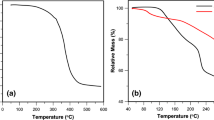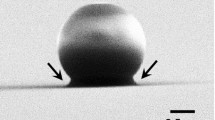Abstract
IT is known1,2, that silica-gas diffusion systems exemplify a type of non-specific activated diffusion process, as opposed to the specific type of diffusion system such as hydrogen-palladium. It seemed that the diffusion of gases through other glass-like materials such as some organic membranes, for example, rubber, might offer further examples of non-specific activated diffusion. The data needed to test this hypothesis were available in papers by Edwards and Pickering3, and by Dewar4. Graham5 first noted the large temperature coefficient of the diffusion process through rubber, and that the diffusion velocities had no connexion with the molecular weights.
Similar content being viewed by others
References
Alty, Phil Mag., 15, 1035 (1933).
Barrer, J. Chem. Soc., 378 (1934).
Edwards and Pickering, Sci. Papers. Bureau of Stds., 16, 327 (1920).
Dewar, Proc. Roy. Inst., 21, 813 (1914-16).
Graham, Phil. Mag., 32, 401 (1866).
Taylor, Hermann and Kemp, Ind.-Eng. Chem., 28, 1255 (1936).
Daynes, Proc. Roy. Soc., A, 97, 286 (1920).
Wroblewski, Wied. Ann., 8, (1879).
Author information
Authors and Affiliations
Rights and permissions
About this article
Cite this article
BARRER, R. Nature of the Diffusion Process in Rubber. Nature 140, 106–107 (1937). https://doi.org/10.1038/140106b0
Issue Date:
DOI: https://doi.org/10.1038/140106b0
- Springer Nature Limited
This article is cited by
-
Theoretical study on the diffusive transport of 2,4,6-trinitrotoluene in polymer-bonded explosive
Journal of Molecular Modeling (2011)
-
The Behaviour of Styrene Butadiene Rubber/Acrylonitrile Butadiene Rubber Blends in the Presence of Chlorinated Hydrocarbons
Journal of Polymer Research (2006)
-
A model for transport of diatomic molecules through elastic solids
Journal of Computer-Aided Materials Design (1993)
-
Die Gaspermeabilit�t von Polybutylenterephthalat in der Umgebung der Einfriertemperatur
Colloid & Polymer Science (1983)
-
Imbibition des graines de Pisum sativum l �re partie, imbibition par trempage
Planta (1966)





